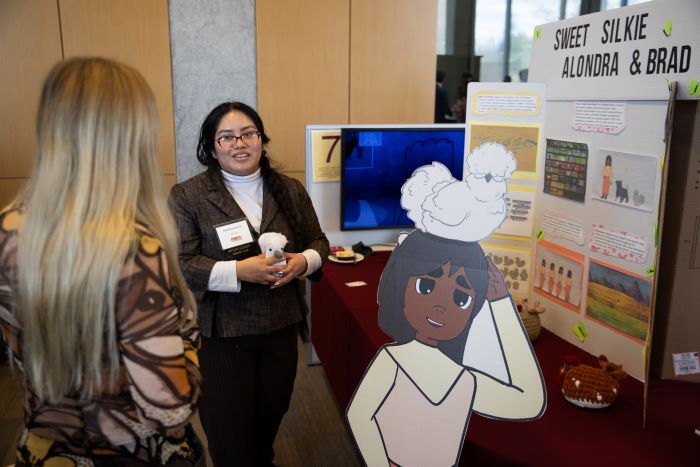
Start up
Passion. Potential. Pitches. Don't miss any of the 2025 New Venture Challenge excitement.
Tune in Friday, April 11 at 1 p.m. for great ideas and fierce competition. Then, join the judges, mentors, spectators and teams as they see who is going home with thousands of dollars in venture financing. The awards broadcast begins at 6:30 p.m. and one team will walk away as the overall best venture.
Central Michigan University’s College of Business Administration is the home of the Isabella Bank Institute for Entrepreneurship and the first Department of Entrepreneurship in the state of Michigan. We are a student-centric hub where experiential, curricular, and external entrepreneurial opportunities intersect.
Our mission is to maximize student success by fostering a campus-wide entrepreneurial mindset that promotes inter-disciplinary collaboration and the creation of new ventures.
We aim to create innovative programming, boost cross-campus and ecosystem collaboration and provide a comprehensive mentoring program.
Our institute provides extracurricular opportunities and is open to all undergraduate and graduate CMU students.
Are you interested in becoming an entrepreneur?
Every journey is unique. Explore the opportunities that interest you.
Experts on Point is a University Communications series focusing on CMU faculty who have special insights into interesting, important and timely topics.
Hot summers for many in Michigan mean heading to one of our abundant lakes for a relaxing dip. Unfortunately, along with rising temperatures is an increased likelihood that people may come in contact with algae that potentially can cause unpleasant or even harmful conditions for them and their pets.

Hunter Carrick, a Central Michigan University Biology faculty member, is an expert on pollution problems in aquatic ecosystems (lakes and stream), particularly those in the Great Lakes region. We talked with him to learn more about how algal blooms grow and what makes some dangerous.
A: They are microscopic algae that multiply and grow in a confined area to the point that you can see them as particles and flakes suspended in the water. Most are harmless and are an important seasonal food for a variety of invertebrates, mollusks, and small fish.
A: These are conditions when rapidly-reproducing algae — typically blue-green in color in freshwater and referred to as cyanobacteria — can be found floating in water or washed up on shore. They produce chemicals as by-products of their normal growth that can be dangerous (even toxic) to a range of invertebrates, vertebrates and humans as the chemical becomes more concentrated in the water. The production of these biochemicals have been linked to a range of harmful conditions, including skin rashes, changes to nervous systems and potentially making pets deathly sick. In addition, when the algae die, the oxygen that it takes to break them down takes oxygen from fish and invertebrates, killing them.
A: The blue-green algae thrive in waters that have an excess of nutrients, specifically phosphorus and nitrogen, which often are the result of household or industrial detergents, lawn fertilizers and urban and agricultural runoff. Some research points the occurrences of algal blooms to the rise of zebra and quagga mussels in the Great Lakes, which eat good algae and release — or avoid eating — blue-green algae in the water, leaving it to grow and concentrate throughout the summer.
A: Yes, the toxic blue-green algae often thrive as the summer progresses. The blooms benefit from the ample sunlight that promotes their growth and warms the temperature of the water. These same weather patterns can produce more intense rain storms, like those we have had during the late spring and summer, which deliver abundant nutrients like phosphorus and nitrogen which fuel more algae growth. The delivery of nutrients, coupled with consistently higher-than-average temperatures of Michigan's lakes, have in a sense created the perfect storm for algal blooms.
A: If you or your children experience symptoms such as runny eyes or nose, stomach pain, vomiting, diarrhea, seizures, weakness and/or headaches, go to the nearest urgent care or call poison control (800-222-1222).
A: An animal that has gone in water contaminated with excessive algae should be rinsed off immediately. If a pet shows symptoms such as vomiting, diarrhea, staggering and seizures, they should be taken immediately to a veterinarian. It is also important to report the case to the Michigan Department of Rural Development at 800-292-3939 or by submitting a Reporting a Reportable Disease Form.
A: Contact the Department of Environment, Great Lakes and Energy at 800-662-9278 or algaebloom@Michigan.gov.

Explore special opportunities to learn new skills and travel the world.

Present your venture and win BIG at the New Venture Challenge.

Boost your entrepreneurial skills through our workshops, mentor meetups and pitch competitions.

Learn about the entrepreneurship makerspace on campus in Grawn Hall.

Present a 2-minute pitch at the Make-A-Pitch Competition and you could win prizes and bragging rights!

Connect with mentors and faculty who are here to support the next generation of CMU entrepreneurs.

Are you a CMU alum looking to support CMU student entrepreneurs? Learn how you can support or donate to the Entrepreneurship Institute.